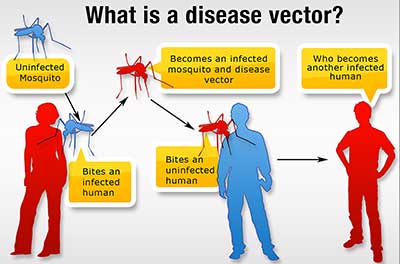Vector Control for Environmental Health Professionals (VCEHP)

VCEHP includes courses addressing Zika virus and other mosquito-borne diseases.
Environmental health professionals are on the frontline of helping individuals, institutions, and communities reduce threats from mosquitoes, ticks, and other vectors. This training—Vector Control for Environmental Health Professionals—emphasizes the use of integrated pest management to address public health pests and vectors that spread pathogens, including Zika virus and others.
Get Started Today
- Visit the Website and Create a New Account: http://lms.southcentralpartnership.org/vcehp.php (you can also register through TRAIN)
- Enroll in VCEHP Courses
What Are the Benefits of This Training?
- It’s free and flexible: Take the courses you want, when you want in this online learning program.
- It’s credible: Learn the latest science and evidence from vector control experts to improve your awareness and understanding of vector control and pest management.
- It’s practical: Access concrete principles, practices, and resources to address vector control issues affecting your community.
What Topics Are Addressed?
The training includes 11 courses. Take all of them or pick and choose (the first three are required, then take courses in any order):

- Vector-Borne Diseases of Public Health Importance
- Integrated Pest Management Basics
- Performance Assessment and Improvement of Vector Control Services
- Tick Biology and Control
- Mosquito Biology and Control
- Toxicology of Pesticides
- Rodent Management
- Pests and Vectors in Food and Housing Environments
- Special Pest Management Considerations for Schools
- Risk Communication Basics
- Bed Bug Biology and Control
What Are People Saying?
“You are providing an incredibly valuable resource for EH Professionals. I appreciate the assistance I received to complete the series, and intend to participate in more classes in the future.” – Food Safety Consultant
“[I am] better able to serve the citizens of my county and the cities within the county. I feel better prepared to respond to questions regarding the use of pesticides. I also found several good references should I have a question that I couldn’t answer.” – Pilot Tester
We tested this course with environmental health, vector control, and pest management staff.
- 4 of 5 reported they would be able to apply acquired knowledge in their work.
- 4 of 5 reported the information they gained will enhance their ability to do their job.
- 9 in 10 agreed that they would recommend this training to a colleague (consistent across all 11 courses).

How Long Does It Take?
For pilot testers, about half of the courses took around an hour each. The rest took between 2 and 2½ hours each.
Who Developed It?
Several groups and individuals worked together to create this training series, which updates CDC’s past popular trainings on vector control. CDC’s National Center for Environmental Health collaborated with National Network of Public Health Institutes, Texas Health Institute, Tulane University, National Environmental Health Association, and additional subject-matter experts in vector control and pest management.
Did You Know?
- Vector-borne diseases are a major public health concern.
- Since 2008, more than 51,000 state and local public health jobs have been lost representing more than 19% of the total state and local health department workforce.
Key Terms
- Integrated Pest Management: a multifaceted approach to managing pests by focusing on (1) not attracting them, (2) keeping them out, and (3) getting rid of them using the safest, most effective methods.
- Pesticides: chemical or biological products that kill pests (for example mosquitoes, ticks, rats, and others).
View this content in a fact sheet version – VCEHP Fact Sheet [PDF – 193 KB]
Check out this article [PDF – 547 KB] about the training in the Journal of Environmental Health, retweet CDC’s post about VCEHP, or read a blog from the Council of State and Territorial Epidemiologists about it.





















.png)












No hay comentarios:
Publicar un comentario